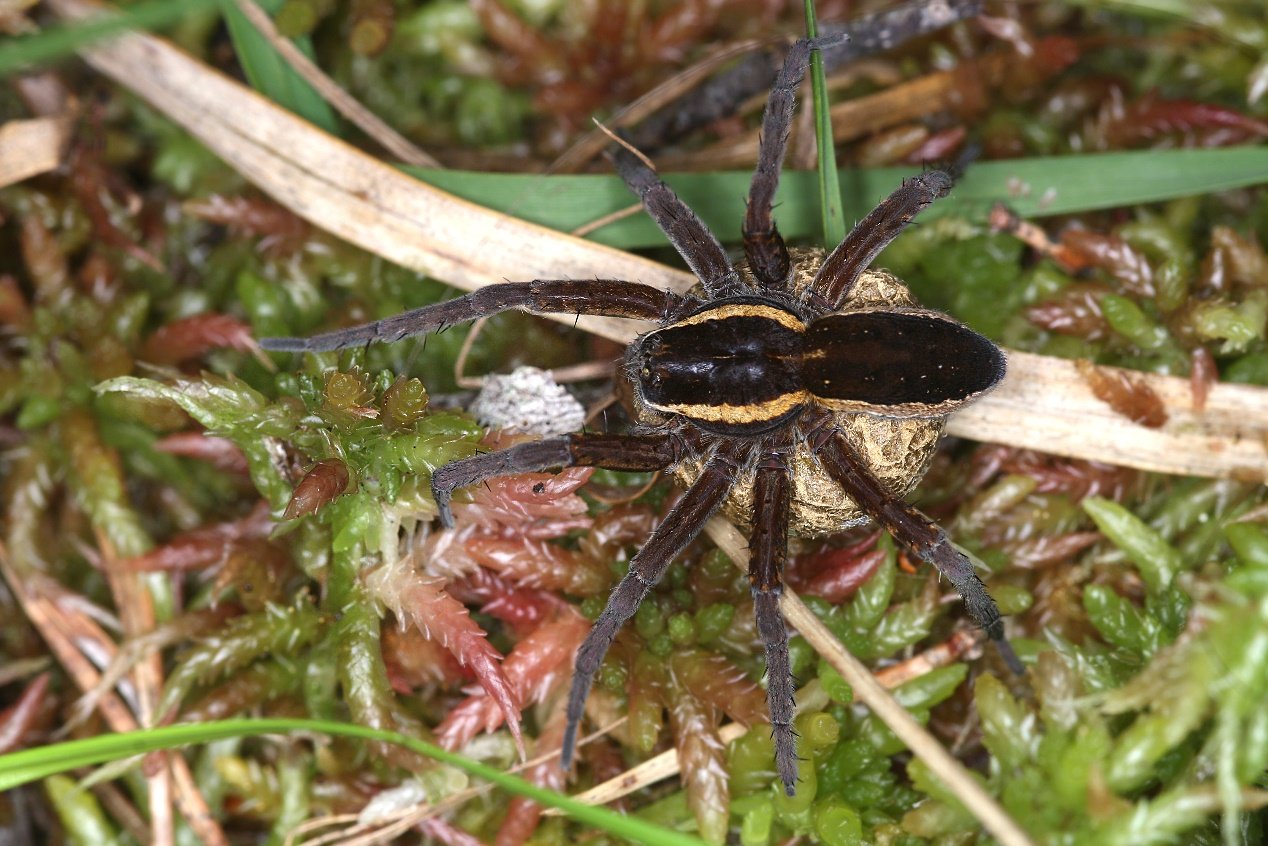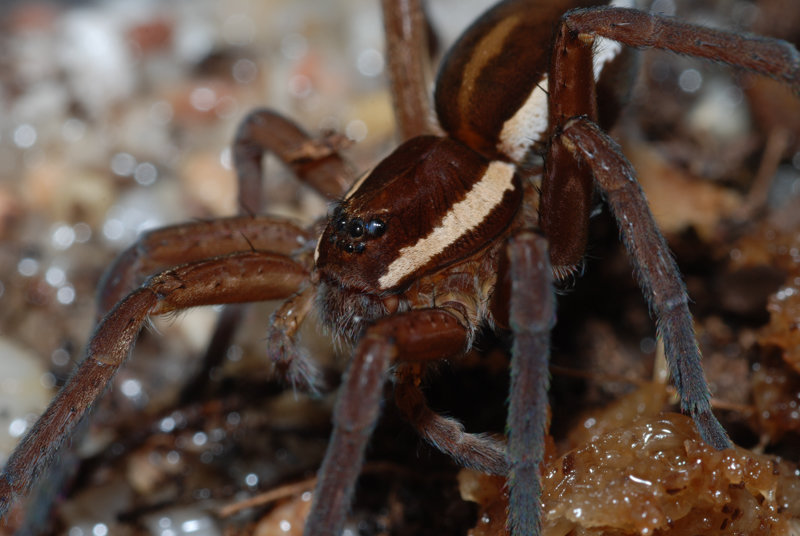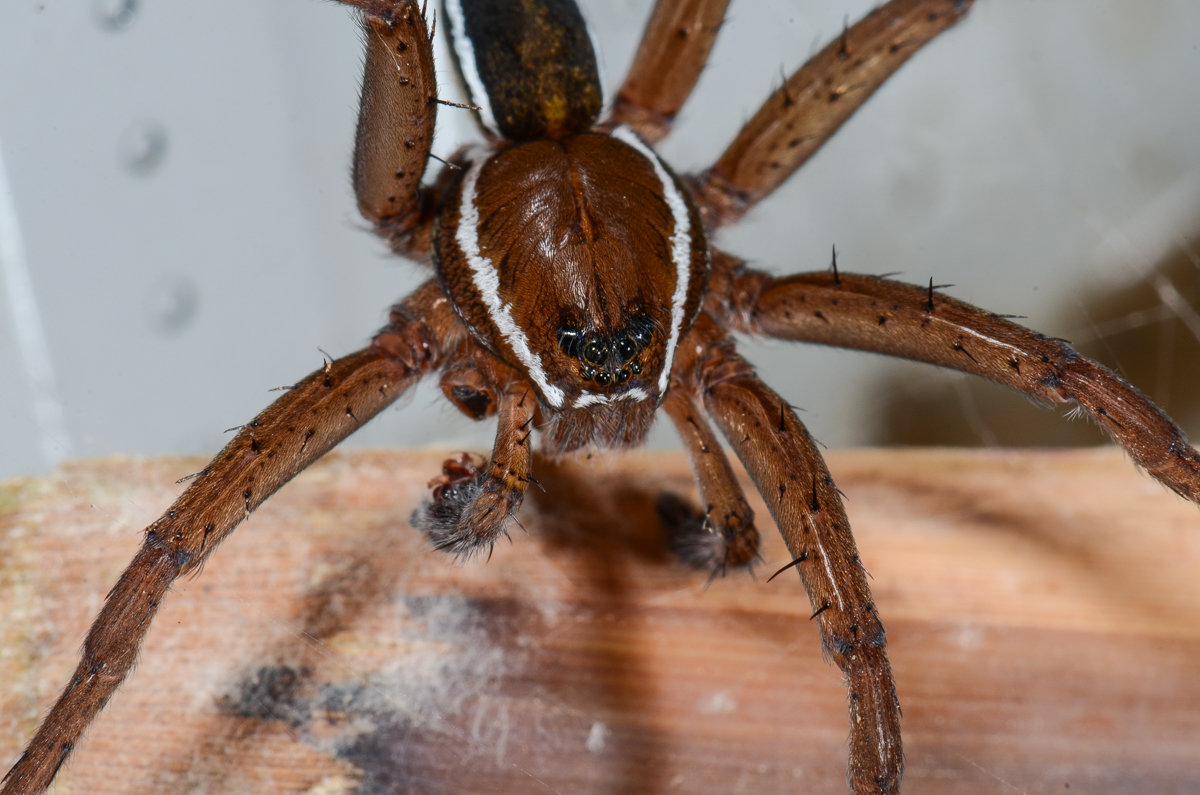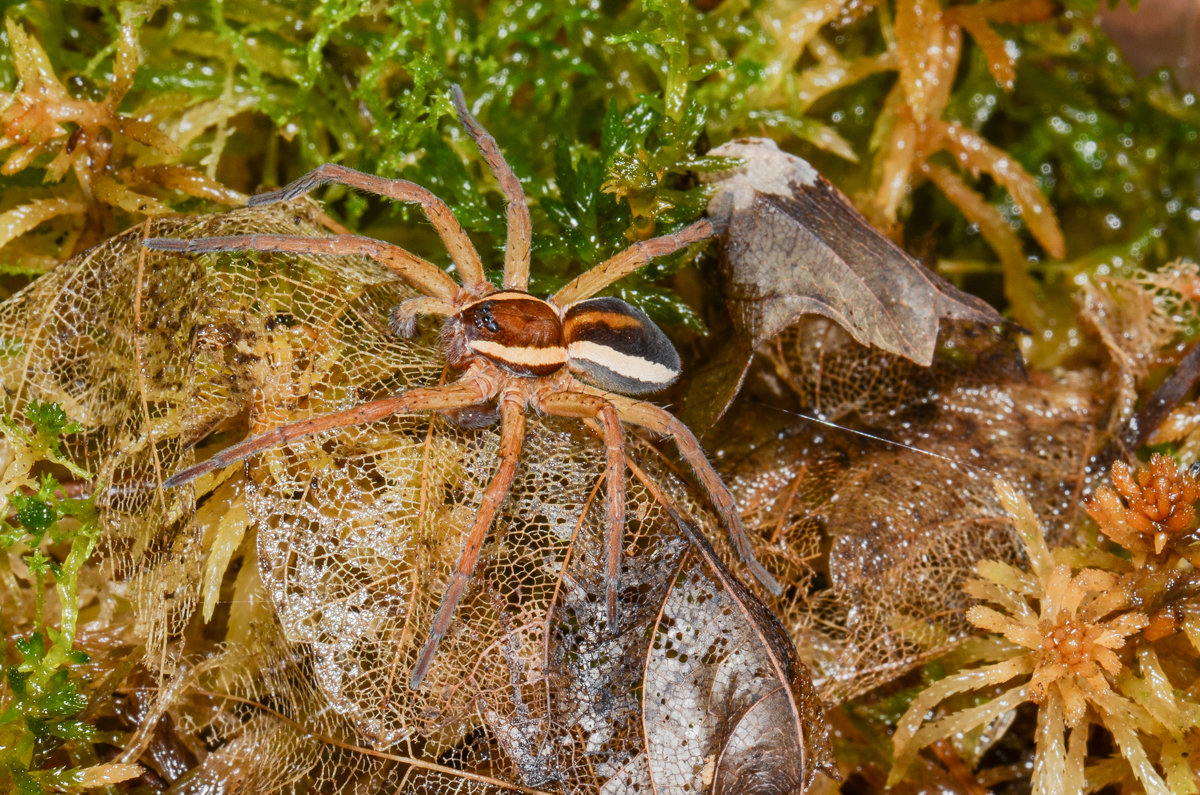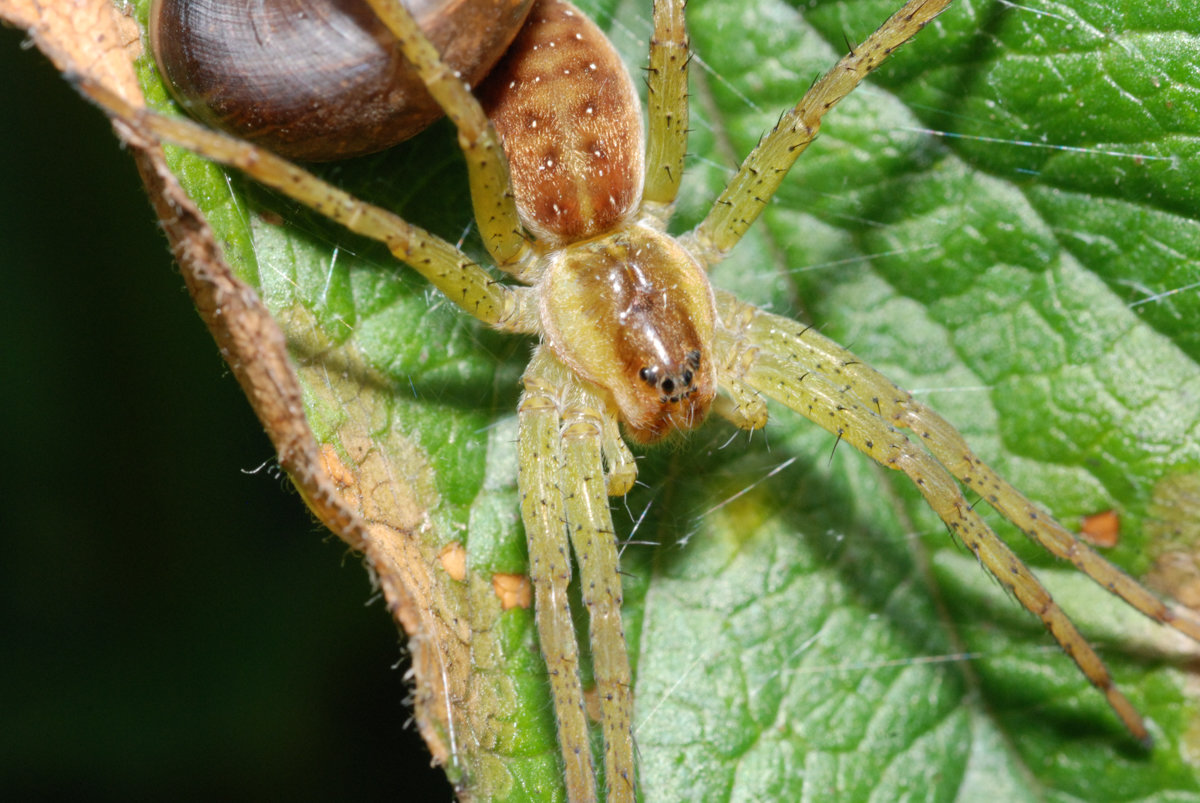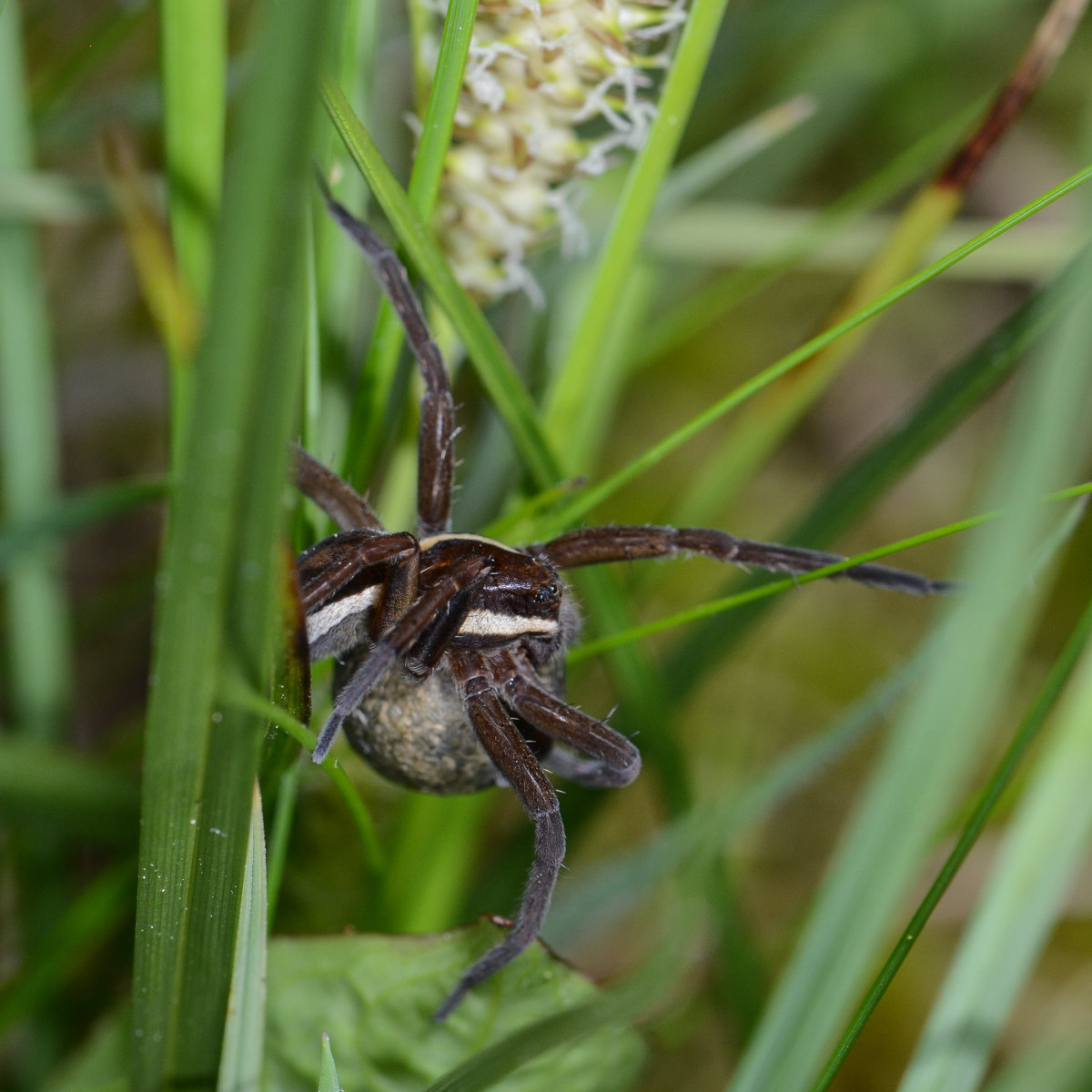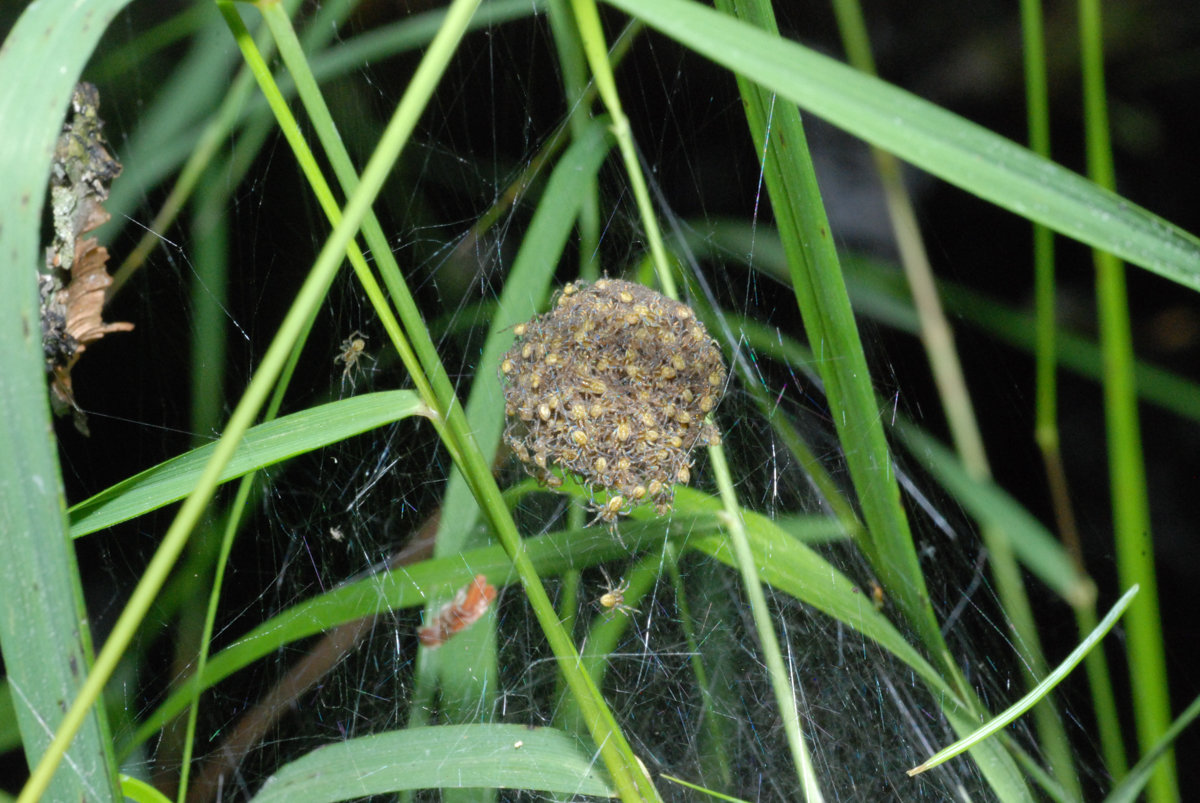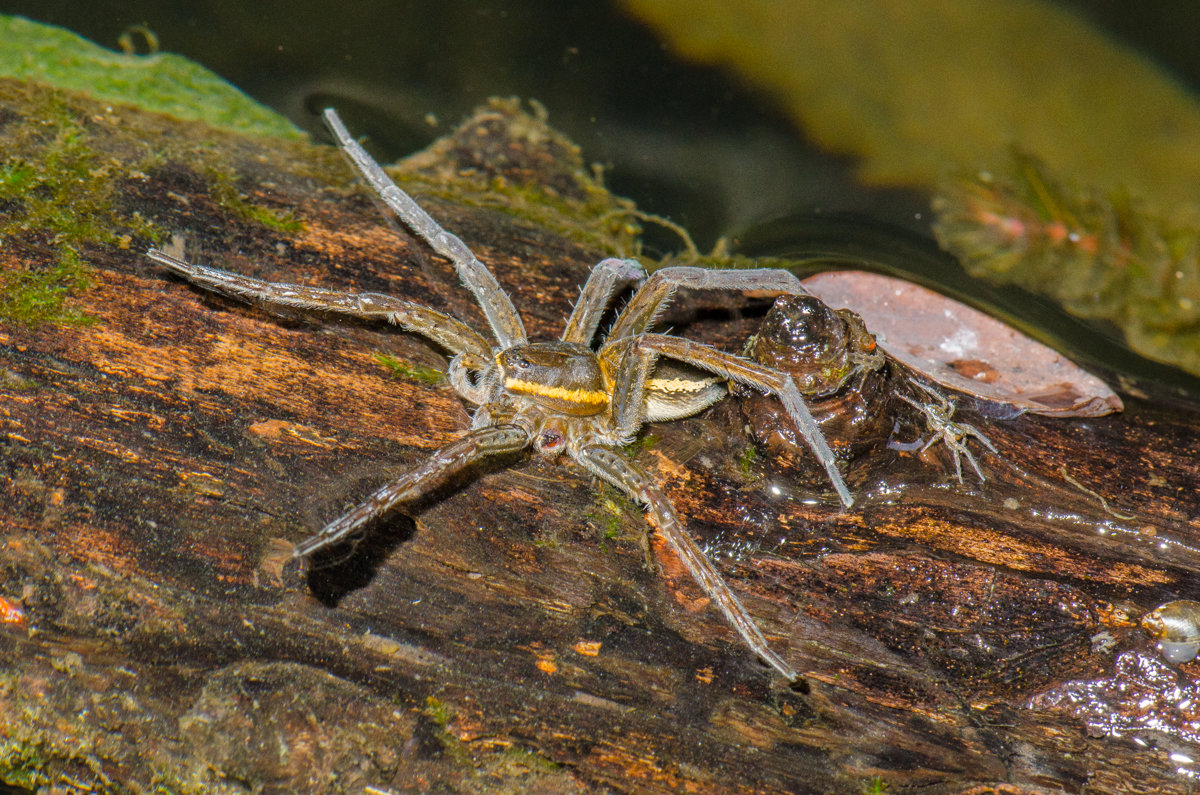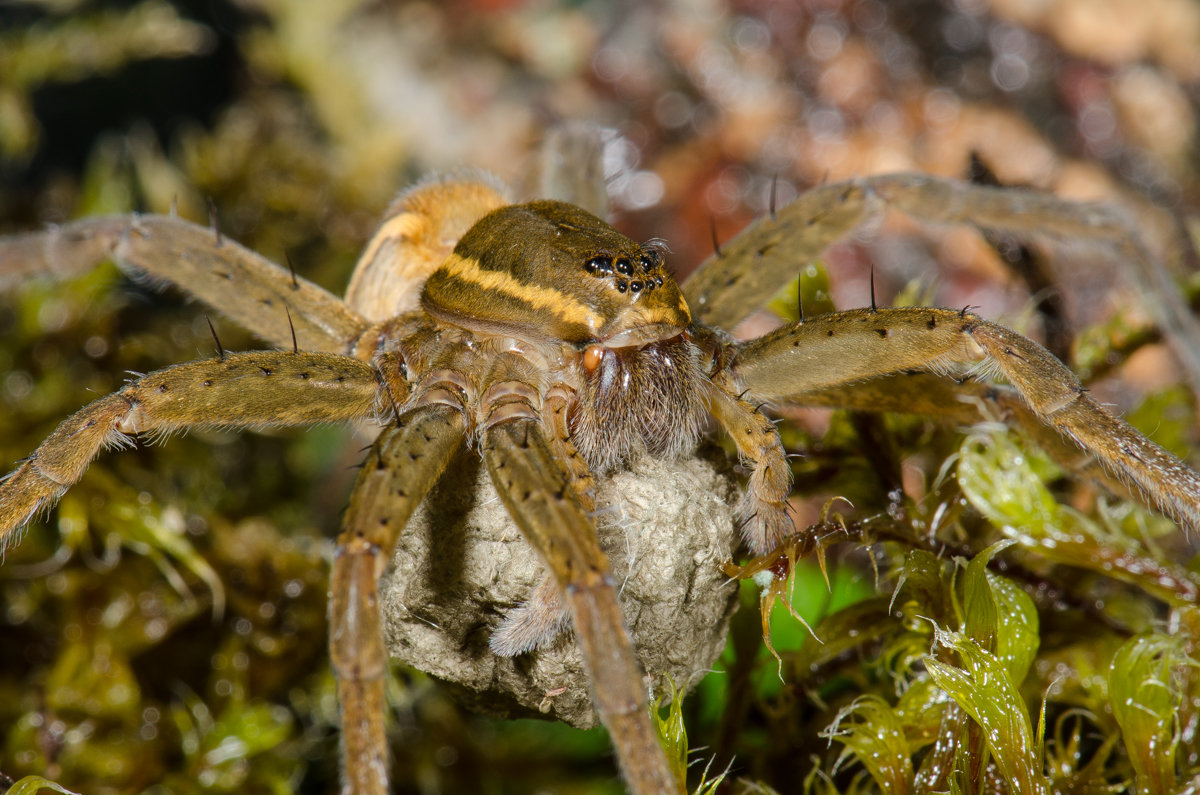Spider of the Year 2020
Raft spider Dolomedes fimbriatus (Clerck, 1757)
The raft spider, Dolomedes fimbriatus (Clerck, 1757), belongs to the nursery web family of spiders (Pisauridae). Worldwide this family has 356 species. In Europe seven species occur. The genus Dolomedes is represented in Europe by two species: D. fimbriatus and D. plantarius (Clerck, 1757).
The raft spider has a Palearctic distribution. In Central Europe it mostly occurs in flatlands through to hills (up to 800 m above sea level), with records up to 1250 m above sea level in Austria.
In some places the species can be found quite often. Due to the destruction of many of its preferred habitats (moorland and wetlands) it has become rarer, although it is not considered endangered. Due to climate change it is likely that in the future they will have to be placed in an endangered category.
Text: Christoph Hörweg
Description
With a body length of 15-22 mm in females and 10-13 mm in males, the raft spider is one of the largest native spiders. The body appears especially strong and stocky. The basic colouration is yellow-brown to blackish-brown (in juveniles greenish to olive) and the sides of the body usually have a pale stripe which extends all the way down along both sides of the cephalothorax and abdomen. These are, however, not always present.
Ecology
The raft spider overpowers its prey as a free-living hunter, without using a web. They prefer to live on the shores of still or (slowly) flowing bodies of water, in moorland, wet meadows, and riparian forests or waterlogged woodland (carrs). Here, the spider sits on the water surface near to plants and waits for (water) insects, tadpoles and small fish. D. fimbriatus moves skillfully when hunting on the water surface. It lays its whole body on the water, but thanks to its thick coat of body hairs it can rely on surface tension and remain above the water. When in danger, or to catch prey, it can dive underwater. During diving an air bubble forms around the body, which bursts after the spider comes back up to the water surface and leaves an emergent dry spider
Mating usually occurs in May or June. From the end of June egg laying takes place and afterwards a ca. 1 cm diameter cocoon (containing up to 1000 eggs) is constantly carried by the female using her mouthparts (and not attached to the spinnerets as in wolf spiders!). Shortly before hatching the cocoon is hung in vegetation near the water’s edge, enclosed by silk threads and guarded. Later further egg laying can take place, however with a reduced number of eggs and smaller cocoon size. Development of the spiderlings apparently takes two years. They usually overwinter as subadults and moult to maturity in early May.
Dolomedes fimbriatus is present throughout almost the whole year, and can be found from at least March to October, especially females. It can be presumed, at least for those that live for more than one year, that the main activity period of males extends from May to August.
The large raft spider
In (Central) Europe there is another species, Dolomedes plantarius, with a similar appearance (usually without the pale stripes) and size (male body length 10-16 mm, females 13-20 mm) and also a similar habitat, perhaps with a preference for larger lakes and moorland. It seems even more closely attached to water, and requires sunny open banks for reproduction. This species is principally encountered from April to August, female a little longer until September. Generally, this species is found only rarely. A definitive identification is, however, only possible from its genital characters.
Text: Christoph Hörweg
As one of the largest native spiders found on the banks of lakes and rivers it is easily visible and also shows remarkable adaptations to this habitat, which is unfortunately increasingly threatened and in danger. The species is especially endangered by building work on banks, the removal of reed beds and water lilies, the drying out of moorland and the reduction in size of suitable wetland habitats.
With the choice of the spider of the year, not only should an ‘unpopular’ group of animals be put into perspective, but reference should also be made to an endangered habitat. At the same time the scientists hope to obtain current data about its distribution. In this sense enjoy the spider of the year and help us with your locality information or a photo to document this species.
The ‘European spider of the year’ is chosen by 83 arachnologists from 26 European countries. Coordination is by the Natural History Museum of Vienna, together with the Arachnologische Gesellschaft (AraGes) and the European Society of Arachnology (ESA).
Christoph Hörweg
Countries involved
Albania, Austria, Belgium, Bulgaria, Croatia, Czech Republic, Denmark, Finland, France, Germany, Great Britain, Hungary, Ireland, Italy, Liechtenstein, Macedonia, The Netherlands, Norway, Poland, Portugal, Serbia, Slovakia, Slovenia, Spain, Sweden, Switzerland.
Supporting societies
- ARABEL - Belgische Arachnologische Vereniging
- ARAGES - Arachnologische Gesellschaft
- BAS - The British Arachnological Society
- CAS - Česká arachnologická společnost
- ESA - European Society of Arachnology
- GIA - Grupo Ibérico de Aracnología
- NATURADATA - Biodiversidade online (Portugal)
- NATURALIS - European Invertebrate Survey-Nederland
Contact for Europe
Dr. Milan Řezáč
Biodiversity Lab, Crop Research Institute
Drnovská 507
161 06 Praha 6 – Ruzyně
Czech Republic
reza(a)cvurv.cz
Distribution
Europe - (link to former maps on spiderling)Europe from araneae - (link)
Austria - (link)
Benelux - (link)
Czech Republic - (link)
Germany from the Atlas of the European Arachnids - (link)
Great Britain - (link)
Switzerland - (link)
Photo galleries
Pierre Ogers Galerie (Les araignées de Belgique e de France)
Wiki of the Spinnen-Forum - (link)
Wikimedia commons - (link)
spiderling.de - (link)
- Arachnologische Gesellschaft 2019 Atlas der Spinnentiere Europas (Arachnida: Araneae, Opiliones, Pseudoscorpiones, Amblypygi, Solifugae, Scorpiones, Schizomida) für Dolomedes fimbriatus – (link) (20.12.2019)
- Bellmann H 2016 Der Kosmos Spinnenführer. Frackh-Kosmos Stuttgart. 429 pp.
- Blick T, Bosmans R, Buchar J, Gajdoš P, Hänggi A, Helsdingen P van, Růžička V, Staręga W & Thaler K 2004 Checkliste der Spinnen Mitteleuropas. Checklist of the spiders of Central Europe. (Arachnida: Araneae). Version 1. Dezember 2004
- CSCF (Centre Suisse de Cartographie de la Faune) 2019 Fauna der Schweiz – Spinnentiere oder Arachniden (Skorpione, Pseudoskorpione, Spinnen, Weberknechte, Milben) – (link) bzw. Verbreitungskarte für Dolomedes fimbriatus: (link) (20.12.2019)
- Foelix RF 2015 Biologie der Spinnen. Edition Chimaira, Frankfurt am Main. 430 pp.
- Hänggi A, Stöckli E & Nentwig W 1995 Lebensräume mitteleuropäischer Spinnen. Charakterisierung der Lebensräume der häufigsten Spinnenarten Mitteleuropas und der mit diesen vergesellschafteten Arten – Miscellanea Faunistica Helvetiae 4: 1-459
- Harms D, Dunlop JA & Schütt K 2009 Neue Nachweise der Gerandeten Wasserspinne Dolomedes plantarius in Brandenburg (Araneae: Pisauridae) – Arachnologische Mitteilungen 37: 1-8. doi: 10.5431/aramit3701
- Helsdingen PJ van 2019 Araneae. In: Fauna Europaea version 2017.06 – (link) (20.12.2019)
- Leroy B, Paschetta M, Canard A, Bakkenes M, Isaia M & Ysnel F 2013 First assessment of effects of global change on threatened spiders: Potential impacts on Dolomedes plantarius (Clerck) and its conservation plans – Biological Conversation 161: 155-163
- Milano F, Pantini P, Cavalcante R & Isaia M 2018 Notes on the Italian distribution of Dolomedes plantarius (Clerck, 1757), species assessed for the IUCN Red List (Araneae: Pisauridae) – Fragmenta Entomologica 50(1): 69-74. doi: 10.4081/fe.2018.285
- Nentwig W, Blick T, Gloor D, Hänggi A & Kropf C 2019 araneae – Spiders of Europe, version 12.2019 – (link) (20.12.2019)
- Nyffeler M, Vetter RS 2018 Black widow spiders, Latrodectus spp. (Araneae: Theridiidae), and other spiders feeding on mammals – Journal of Arachnology 46: 541-548
- Reichholf JH & Steinbach G 1997 Die grosse Enzyklopädie der Insekten, Spinnen- und Krebstiere, Band 1. Bertelsmann Lexikon Verlag Gütersloh. 360 pp.
- Wiki AraGes 2019 Wiki der Arachnologischen Gesellschaft e.V. – (link) (20.12.2019)
- World Spider Catalog 2019 World Spider Catalog, version 20.5. Natural History Museum Bern – (link) (20.12.2019)



